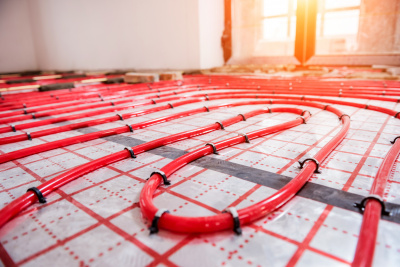Is underfloor heating efficient?
Underfloor heating can be incredibly efficient when installed properly. With the ability to heat larger areas than radiators can, it can be more cost-effective to run. In addition, since the heat is generated from the ground rather than from the air, it is a great way to conserve energy and reduce the running costs of your heating system overall. The efficiency of this type of heating also depends on the type of system you use. Electric systems tend to be more expensive to install, but they provide consistent heat throughout the room, while water-based systems require less energy to run.
Which factors affect efficiency?
There are various factors that affect the efficiency of underfloor heating. The main ones are the substrate of the floor, the output of the system, insulation, and the floor finish. An ideal floor substrate would be something with a low thermal resistance such as concrete or screed. The output of the system should be high enough to heat the room efficiently without raising the temperature too quickly, causing discomfort. Additionally, good insulation should be installed under the floor to help keep the heat in and reduce energy bills. Finally, a suitable floor finish must be chosen to ensure that the heat is not lost and to prevent any damage to the flooring over time.

Need assistance finding underfloor heating near you?
Get a QuoteAre insulation boards necessary?
For most water-based underfloor heating systems, insulation boards are required to keep the floor warm and prevent the loss of heat. This is because the water temperature of the heating system must be kept at a comfortable level so that it is not too hot or cold. Insulation boards also help to increase the efficiency of the system by providing an extra layer of protection between the floor and the ambient temperature.
Controlling Your Underfloor Heating
When it comes to controlling your underfloor heating, it’s important to find the right balance between comfort and efficiency. This means that you should aim to set the thermostat to a comfortable temperature that suits your lifestyle, while also ensuring that it runs at a low enough temperature to avoid wasting energy. This can be achieved by using thermostats or thermostatic valves that allow you to control the temperature of each room individually.
Incorporating Renewables
To make your underfloor heating even more efficient, you could consider incorporating renewable sources of energy, such as solar PV or solar thermal. Solar PV can be used to generate electricity which can then be used to power your underfloor heating, cutting your reliance on the grid. Solar thermal can also be combined with underfloor heating systems, helping to reduce your energy bills further. This is a great option for those who want to reduce their carbon footprint and energy bills, as well as generate some of their own energy.
Overall, underfloor heating can be an efficient way to heat a home if installed correctly. With the right floor substrate, output, insulation, and floor finish, you can get the most out of your system and reduce your energy bills. Furthermore, by incorporating renewable energy sources, you can further increase the efficiency of your system and help to reduce your carbon footprint.
In this article:
